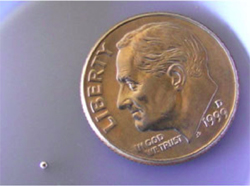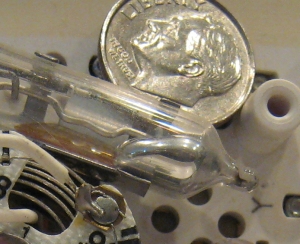
Yes and no. Compact fluorescent light bulbs, commonly referred to as CFL bulbs, do contain mercury, which is a hazardous material. However, the amount is very small and is less than the amount used in standard linear fluorescent bulbs which have been in use in homes, businesses, and schools for decades.

Figure 1: Size comparison of mercury found in a typical CFL bulb sold in the U.S. (Photo courtesy of Monte Helm, Ph.D. Fort Lewis College)
Two-thirds of the CFL bulbs manufactured by the member companies of the National Electrical Manufacturers Association (NEMA) in 2004 contained less than 5 mg of mercury. Ninety-six percent of them contained less than 10 mg. And, according to the Energy Star program of the U.S. Environmental Protection Agency (EPA) and the Department of Energy (DOE), the amount of mercury contained in CFLs manufactured by NEMA companies has dropped by at least 20 percent since July 2007.
By comparison, the majority of standard linear fluorescent bulbs, that are often found in household fixtures in kitchens, bathrooms, and garages, contain at least 5 mg per bulb with 40% containing 10 mg or more, ranging as high as 100 mg per bulb. Older fever thermometers can range up to 1,000 mg. Older thermostats, like the one I recently replaced in my home which was built just over 10 years ago, can range up to 4,500 mg, the equivalent of 900 CFL bulbs!
As with any potentially harmful product in your home (e.g., cleaning products, medications, etc.) care should be taken in using and disposing of CFL bulbs properly. Similar to the linear fluorescent bulbs, CFL’s are ideally used in locations that would not be susceptible to breaks, such as overhead bathroom fixtures and ceiling-mounted room lighting. CFL’s can be used in almost any lamp, including those with dimmers (though you’ll need a specific type of CFL), but caution should be exercised in minimizing the possibility for a break.
With proper use, CFL bulbs can greatly reduce both household energy consumption for lighting and environmental mercury release. The table below details both the kWh in savings provided by the utilization of a CFL versus a standard incandescent light bulb and the reduction in environmental mercury emissions resulting from reduced electricity generation at power plants
And the handling of burned out CFL bulbs has become easier as well, with both Home Depot (press release) and Ikea stores providing recycling programs. Alternately, the EPA and Earth911 provide methods for determining local recycling options.

Figure 3: Environmental mercury release - CFL versus Incandescent (Source: U.S. Energy Star Program)
Additional Reading
- Banned light bulbs? Is the government saying no to incandescents? – PolitiFact
- Mercury Use in Lighting – Northeast Waste Management Officials’ Association
- FAQ -Information on Compact Fluorescent Light Bulbs (CFLs) and Mercury – Energy Star program (EPA/DOE)
- What to Do is a Fluorescent or Other Mercury-Containing Light Bulb Breaks – U.S. EPA
- What You Need to Know about Mercury in CFLs – Tennessee Valley Authority (TVA)
- Tips for Buying and Using Energy-Efficient Bulbs – Environmental Defense Fund (EDF)








Zoinks great article!
Posted by Dr. Z Bulbs | February 12, 2009, 3:07 pmWon’t it be better to choose another alternative for CFLs..We know their ill-effects.
Won’t LED be a better option
Posted by anita | February 27, 2009, 11:40 pmLED’s, like CFL’s, are great options for particular applications. Neither fits as a universal alternative. The cost associated with LED’s along with their heat sensitivity and directional light distribution prevent them from being a viable alternative outside of very specific usages at this point. It will be interesting to see where technology research will take us in the next few years. OLED applications have always been intriguing.
Posted by Michael Searcy | March 2, 2009, 5:33 pmLED lightsmay be a good alternative in the future, but right now they create a lot of harmful pollutants during the manufacturing process which offset their ability to truely be beneficial to the environment…
Posted by Stephany | April 17, 2009, 1:02 pmwow i always thought they were safe now i know.
Posted by Danayja | June 2, 2009, 2:11 pmI am surprised about the heat generated by these bulbs. In my signs, a hot tube signifies a poorly processed unit that is going to fail early. What is with that? Any imput would be appreciated. Bill
Posted by Bill Cheezeburger | June 4, 2009, 11:33 pm